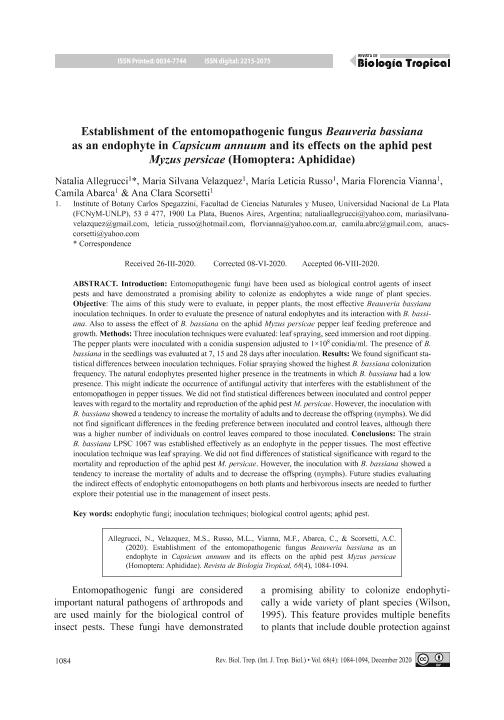Artículo
Establishment of the entomopathogenic fungus Beauveria bassiana as an endophyte in Capsicum annuum and its effects on the aphid pest Myzus persicae (Homoptera: Aphididae)
Título:
Establecimiento del hongo entomopatógeno Beauveria bassiana como endófito en Capsicum annuum y sus efectos sobre la plaga del áfido Myzus persicae (Homoptera: Aphididae)
Allegrucci, Natalia ; Velázquez, María Silvana
; Velázquez, María Silvana ; Russo, Maria Leticia
; Russo, Maria Leticia ; Vianna, María Florencia
; Vianna, María Florencia ; Abarca, Camila Lucía
; Abarca, Camila Lucía ; Scorsetti, Ana Clara
; Scorsetti, Ana Clara
 ; Velázquez, María Silvana
; Velázquez, María Silvana ; Russo, Maria Leticia
; Russo, Maria Leticia ; Vianna, María Florencia
; Vianna, María Florencia ; Abarca, Camila Lucía
; Abarca, Camila Lucía ; Scorsetti, Ana Clara
; Scorsetti, Ana Clara
Fecha de publicación:
12/2020
Editorial:
Universidad de Costa Rica
Revista:
Revista de Biología Tropical
ISSN:
0034-7744
Idioma:
Inglés
Tipo de recurso:
Artículo publicado
Clasificación temática:
Resumen
Introduction: Entomopathogenic fungi have been used as biological control agents of insectpests and have demonstrated a promising ability to colonize as endophytes a wide range of plant species.Objective: The aims of this study were to evaluate, in pepper plants, the most effective Beauveria bassianainoculation techniques. In order to evaluate the presence of natural endophytes and its interaction with B. bassi-ana. Also to assess the effect of B. bassiana on the aphid Myzus persicae pepper leaf feeding preference andgrowth. Methods: Three inoculation techniques were evaluated: leaf spraying, seed immersion and root dipping.The pepper plants were inoculated with a conidia suspension adjusted to 1×108 conidia/ml. The presence of B.bassiana in the seedlings was evaluated at 7, 15 and 28 days after inoculation. Results: We found significant sta-tistical differences between inoculation techniques. Foliar spraying showed the highest B. bassiana colonizationfrequency. The natural endophytes presented higher presence in the treatments in which B. bassiana had a lowpresence. This might indicate the occurrence of antifungal activity that interferes with the establishment of theentomopathogen in pepper tissues. We did not find statistical differences between inoculated and control pepperleaves with regard to the mortality and reproduction of the aphid pest M. persicae. However, the inoculation withB. bassiana showed a tendency to increase the mortality of adults and to decrease the offspring (nymphs). We didnot find significant differences in the feeding preference between inoculated and control leaves, although therewas a higher number of individuals on control leaves compared to those inoculated. Conclusions: The strainB. bassiana LPSC 1067 was established effectively as an endophyte in the pepper tissues. The most effectiveinoculation technique was leaf spraying. We did not find differences of statistical significance with regard to themortality and reproduction of the aphid pest M. persicae. However, the inoculation with B. bassiana showed atendency to increase the mortality of adults and to decrease the offspring (nymphs). Future studies evaluatingthe indirect effects of endophytic entomopathogens on both plants and herbivorous insects are needed to furtherexplore their potential use in the management of insect pests.
Archivos asociados
Licencia
Identificadores
Colecciones
Articulos(CCT - LA PLATA)
Articulos de CTRO.CIENTIFICO TECNOL.CONICET - LA PLATA
Articulos de CTRO.CIENTIFICO TECNOL.CONICET - LA PLATA
Citación
Allegrucci, Natalia; Velázquez, María Silvana; Russo, Maria Leticia; Vianna, María Florencia; Abarca, Camila Lucía; et al.; Establishment of the entomopathogenic fungus Beauveria bassiana as an endophyte in Capsicum annuum and its effects on the aphid pest Myzus persicae (Homoptera: Aphididae); Universidad de Costa Rica; Revista de Biología Tropical; 68; 4; 12-2020; 1084-1094
Compartir
Altmétricas



